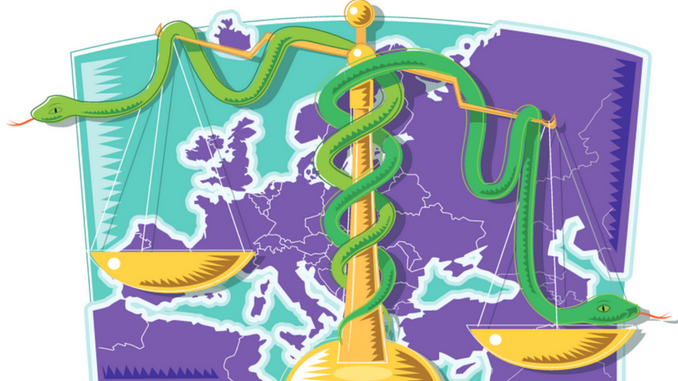
As we learn more about what lies behind the differences in cancer outcomes across Europe, the question becomes: how do we end them?
This article was first published in The Oncologist vol.18 no.12, and is republished with permission. © 2013 AlphaMed Press. doi:10.1634/theoncologist.2013-0438
Are We Winning the War on Cancer?” was the rather provocative title of the World Oncology Forum in Lugano, Switzerland, at the end of 2012[1]. While significant progress has been made over the last 30 years, with European oncology at the forefront of many advances, a review of cancer outcome data indicates significant disparities between different European countries[2] and indeed sometimes within regions of the same country. A recent publication comparing the United Kingdom’s Global Burden of Diseases, Injuries, and Risk Factors Study 2010 (GBD 2010) with 18 other comparator nations (the original 15 members of the European Union, Australia, Canada, Norway, and the United States) for the years 1990 and 2010, identified cancer as one of the diseases for which differences in premature mortality could be identified[3]. What are the reasons for these differences? And more importantly, what can we do to close the gap?
Interpreting cancer outcomes
In an attempt to answer this pertinent question, and to use the information to help direct health policy in cancer, the Department of Health in England initiated the International Cancer Benchmarking Partnership (ICBP) in 2009 to study international variations in cancer survival data. The ICBP involves 12 different jurisdictions in six countries: Australia (New South Wales, Victoria), Canada (Alberta, British Columbia, Manitoba, Ontario), Denmark, Norway, Sweden and the United Kingdom (England, Northern Ireland, Wales). Data from population-based cancer registries in the 12 jurisdictions were analysed for 2.4 million adults diagnosed with primary colorectal, lung, breast or ovarian cancer during the period 1995–2007. While the data indicated that relative survival for all four cancers improved during the study period, there were still significant differences between the different countries, with persistently higher survival rates in Australia, Canada and Sweden, contrasting with persistently lower survival rates in Denmark and the UK[4]. While the causes for these differences are undoubtedly multifactorial, later stage at diagnosis, particularly for colorectal and lung cancer, and differences in treatment or access to treatment (with survival within stage being lower in the UK than elsewhere, particularly for late-stage disease for breast and ovarian cancer) appear to be playing a role. The ICBP has highlighted the utility of precise comparative investigations of international cancer outcome data and how this approach can help inform changes in cancer policy to address cancer disparities between nations and regions.
The ICBP study also draws attention to the fact that there are differences in survival in patients aged 65 and older when compared with their younger counterparts[4]; this trend has been reported in a number of studies[5]. Increasingly it appears that older patients are being undertreated, and this inequality is resulting in poorer survival in older patients and must be addressed.
Palliative care: a case for earlier intervention?
In caring for patients with advanced cancer, be they young or old, we also need to change our mindset. While traditionally, the use of palliative care has been associated solely with end-of-life-care, increasingly the evidence suggests that palliative care services may not be delivering optimal benefit in this setting. In contrast, a number of recent landmark studies have highlighted that early introduction of palliative care in metastatic disease can yield significant benefit for the advanced cancer patient, with gains seen in improved quality of life and mood, and possibly also in improved survival[6,7].
Getting our message across
While we need to address potential deficits in cancer health systems that lead to disparities in outcomes, we can also approach the problem from the individual’s viewpoint, by promoting public awareness campaigns stressing the need for early diagnosis, the availability of cancer screening programmes, and the influence of lifestyle factors such as smoking, alcohol, and obesity on the risk of getting cancer. In the UK, survey data suggest that unprompted public awareness of cancer warning signs is low, except for the classic tumour symptom of lump or swelling, and that barriers to seeking help exist. More recent data also show that 24% of all cancer patients in England present as emergencies, and these patients have poorer outcomes than those being diagnosed through other routes[8]. Public Health England, working in partnership with the Department of Health and National Health Service England, launched the ‘Be Clear on Cancer’ awareness campaigns to address some of these issues. These campaigns encourage people to contact their community doctor/general practitioner if they experience specific symptoms.
Positive results from pilot programmes have underpinned national cancer awareness campaigns for colorectal and lung cancer and have informed additional local, regional, and national initiatives. The most recent data from the regional lung campaign suggest that it led to the diagnosis of more cases of lung cancer, with statistically significantly more small cell lung cancers (SCLC) staged as ‘limited’ rather then ‘extensive’. The data also suggest a trend toward earlier stage at diagnosis of non-small-cell lung cancer (NSCLC). This was accompanied by a statistically significant increase in surgical resections and a trend toward lower performance status at diagnosis. None of the results were replicated in non-campaign areas.[9]
Supporting the needs of the cancer survivor
While efforts in cancer care tend to focus on improving outcomes, the needs of the cancer survivor must also be considered. According to EUROCARE 4, there are nearly 14 million cancer survivors in Europe[10], and there is a significant requirement to incorporate cancer survivorship as a key output of national cancer control programmes, such that survivors can live beyond cancer and return to active life. Programmes such as the UK’s National Cancer Survivorship Initiative, launched in 2008 as part of the UK Cancer Reform Strategy[11], the Victoria Cancer Survivorship Program, launched in Australia in 2011[12], and the Livestrong Centers of Cancer Survivorship Excellence in the US, allow a precise evaluation of the needs of the cancer survivor through a comprehensive data gathering and evaluation process. This process thus allows models of care to be put in place to optimise the quality of life for the cancer survivor returning to active living. The use of patient reported outcomes measures (PROMs) can help inform this process[13]. Cancer survivor programmes have also been developed in Italy, the Netherlands, Germany and Scandinavia, and are a significant component of the strategy of the European Cancer Patient Coalition, as they seek to develop an EU cancer survivorship plan[14].
Conclusions
Despite the improvements that have been made over the last 30 years, cancer will soon rival cardiovascular disease as the major cause of premature disease mortality in Europe[15]. Comparator studies have revealed significant differences in outcomes between European countries and regions. These disparities reflect worrying inequalities in access to information, care and support at all stages of the cancer journey. While the reasons for these inequalities are multifactorial, precise enumeration and evaluation of outcome differences in Europe can help underpin the refinement of cancer policies to address these critical issues. We are building the evidence base that helps explain the ‘cancer gap’ in Europe. What we now need is strong leadership to implement the changes that are required to bridge that gap.
Author affiliations
Sean Duffy, Medical Directorate National Health Service England, Leeds, UK; Mike Richards, Care Quality Commission, London, UK; Peter Selby, Department of Cancer Medicine, Leeds Institute of Cancer and Pathology, University of Leeds, UK; Mark Lawler, Centre for Cancer Research and Cell Biology, School of Medicine, Dentistry and Biomedical Sciences, Queen’s University Belfast, Northern Ireland





